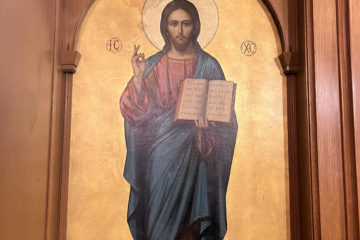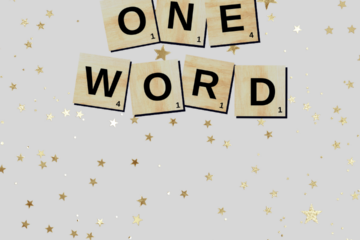When Jesus had spoken these words, He lifted up His eyes to heaven and said, “Father, the hour has come; glorify Thy Son that the Son may glorify Thee, since Thou hast given him power over all flesh, to give eternal life to all whom Thou hast given Him. And this is eternal life, that they know Thee the only true God, and Jesus Christ whom Thou hast sent. I glorified Thee on earth, having accomplished the work which Thou gavest me to do; and now, Father, glorify Thou Me in Thy own presence with the glory which I had with Thee before the world was made. “I have manifested Thy name to the men whom Thou gavest me out of the world; Thine they were, and Thou gavest them to Me, and they have kept Thy word. Now they know that everything that Thou hast given Me is from Thee; for I have given them the words which Thou gavest Me, and they have received them and know in truth that I came from Thee; and they have believed that Thou didst send Me. I am praying for them; I am not praying for the world but for those whom Thou hast given Me, for they are Thine; all Mine are Thine, and Thine are Mine, and I am glorified in them. And now I am no more in the world, but they are in the world, and I am coming to Thee. Holy Father, keep them in Thy name, which Thou hast given me, that they may be one, even as We are one. While I was with them, I kept them in Thy name, which Thou hast given Me; I have guarded them, and none of them is lost but the son of perdition, that the scripture might be fulfilled. But now I am coming to Thee; and these things I speak in the world, that they may have My joy fulfilled in themselves. John 17: 1-13 (Sunday of the Holy Fathers)
In today’s Gospel lesson, we read what is called “The High Priestly Prayer” of Christ, the prayer that Christ offered over His disciples, and indeed over the whole world, before His Passion. His prayer was a prayer for unity of the faithful and a unity of the faith. In His prayer, He also was teaching us about the relationship between Him and His Father.
Jesus tells us that eternal life is to know God the Father, and Jesus Christ, and to know them eternally. He asks the Father to glorify Him with the glory which Son had with the Father from before the world was created. This not only speaks to the eternal Divinity of the Son of God but of the timelessness of God. His prayer is for us to share the timelessness of eternity, with the bounds of time that control us in our earthly life.
As I mentioned in yesterday’s reflection, today we remember the 318 Holy Fathers of the First Ecumenical Council in Nicaea, who in the year 325, authored the Nicene Creed, which we confess at every Divine Liturgy. In the English language, the Creed is just over 200 words which describe succinctly what it is we believe about the Holy Trinity. The reason this Gospel is read today is because it talks about the relationship between God the Father and God the Son, which is stated in the Creed.
In order to be a Christian, there are a few things that one needs to believe. The first is that God created the heavens and the earth. Someone greater than us created the world and created the first people in the world. God made everything and He made it perfect. He created the first human beings as perfect people also. He did not create them with inherent flaws. He did endow them with the gift of free will.
The second thing one needs to believe is that the world fell through sin. Mankind used its free will to go away from God, and this event is called the Fall. The Fall opened a “Pandora’s Box” of bad things for the world—sickness, strife, and eventually death.
God, because of His love, wanted to redeem the world, to give mankind another chance. But in order to accomplish this, two things needed to happen. Someone had to pay the debt for our first sin. And mankind was again presented with a choice—to be faithful or to stray. In order for our debt of sin to be paid, God incarnate His own Son, Jesus Christ, who came to the earth as a human being, and died on the cross for us sins. This happened in the year 29 A.D., during the reign of Pontius Pilate. Pontius Pilate is mentioned by name in the Creed in order to historically date the event of the crucifixion. It did happen, that is historical fact. The Resurrection is a matter of faith. It is the choice given to Adam and Eve, to, of their own free will, believe in the love and goodness of God, or to not. Faith is not imposed on us—we offer it of our own free will.
We just celebrated the Ascension of Christ into heaven, forty days after the Resurrection. And next week, we will celebrate Pentecost, when the Holy Spirit came down from heaven and offered the gift of grace to the Disciples and Apostles, which He continually offers us today. The third part of the Creed concerns the Holy Spirit, the “Creator of Life, who proceeds from the Father, who together with the Father and the Son is worshipped and glorified, who spoke through the prophets,” and still speaks through people to this day.
The last part of the Creed concerns the Church—that it is to be “One, Holy, Catholic (meaning universal) and Apostolic” (it is supposed to keep continuity from the time of the Apostles until the present and into the future.) We acknowledge baptism as the means by which we enter the church, and we spend our lives learning, preparing and “looking” “for the Resurrection of the dead and the life of the age to come.”
The Divine Liturgy is offered almost entirely in the plural—it is “we” and “us” who pray to the Lord. The Creed, however, is recited in the first person. Because to believe is a personal choice, it is something that “I” must do, that no one can do for me or impose on me.
I believe in One God, Father Almighty, Creator of heaven and earth, and of all things visible and invisible.
And in one Lord Jesus Christ, the only-begotten Son of God, begotten of the Father before all ages; Light of Light, true God of true God, begotten, not created, of one essence with the Father, through Whom all things were made. Who for us men and for our salvation came down from heaven and was incarnate of the Holy Spirit and the Virgin Mary and became man. He was crucified for us under Pontius Pilate, and suffered and was buried; and He rose on the third day, according to the Scriptures. And He ascended into heaven and is seated at the right hand of the Father; He will come again in glory to judge the living and the dead. His Kingdom shall have no end.
And in the Holy Spirit, the Lord, the Creator of life, who proceeds from the Father, who together with the Father and the Son is worshipped and glorified, Who spoke through the prophets.
In one, holy, catholic and apostolic Church, I confess one baptism for the forgiveness of sins. I look for the Resurrection of the dead, and the life of the ages to come. Amen.
Prayer of Protection from the Coronavirus
(Prayer by Grace Bishop Alexis (Trader) of Bethesda)
O God Almighty, Lord of heaven and earth, and of all creation visible and invisible, in Your ineffable goodness, look down upon Your people gathered in Your name. Be our helper and defender in this day of affliction. You know our weakness. You hear our cry in repentance and contrition of heart. O Lord who loves mankind deliver us from the impending threat of the corona virus. Send Your Angel to watch over us and protect us. Grant health and recovery to those suffering from this virus. Guide the hands of physicians, and preserve those who are healthy that we may continue to serve You in peace and glorify Your most honorable and majestic Name, of the Father and of the Son and of the Holy Spirit, now and forever and to the ages of ages. Amen.
Recite the Creed today. Over your lifetime, learn what it means, so that you can make the statement “I believe” with confidence and conviction.
The Prayer Team now has its own dedicated website! There you may find a database for past prayer team messages as well as books by Fr. Stavros and other information about his work and St. John the Baptist Greek Orthodox Church in Tampa, FL.
These readings are under copyright and is used by permission. All rights reserved. These works may not be further reproduced, in print or on other websites or in any other form, without the prior written authorization of the copyright holder: Reading © Holy Transfiguration Monastery – Brookline, MA, Apolytikion of Abbot Marcellus © Narthex Press, Kontakion of Abbot Marcellus © Holy Transfiguration Monastery – Brookline, MA.
The Revised Standard Version of the Bible is copyrighted 1946, 1952, 1971, and 1973 by the Division of Christian Education of the National Council of the Churches of Christ in the U.S.A. and used by permission. From the Online Chapel of the Greek Orthodox Archdiocese of America.


0 Comments